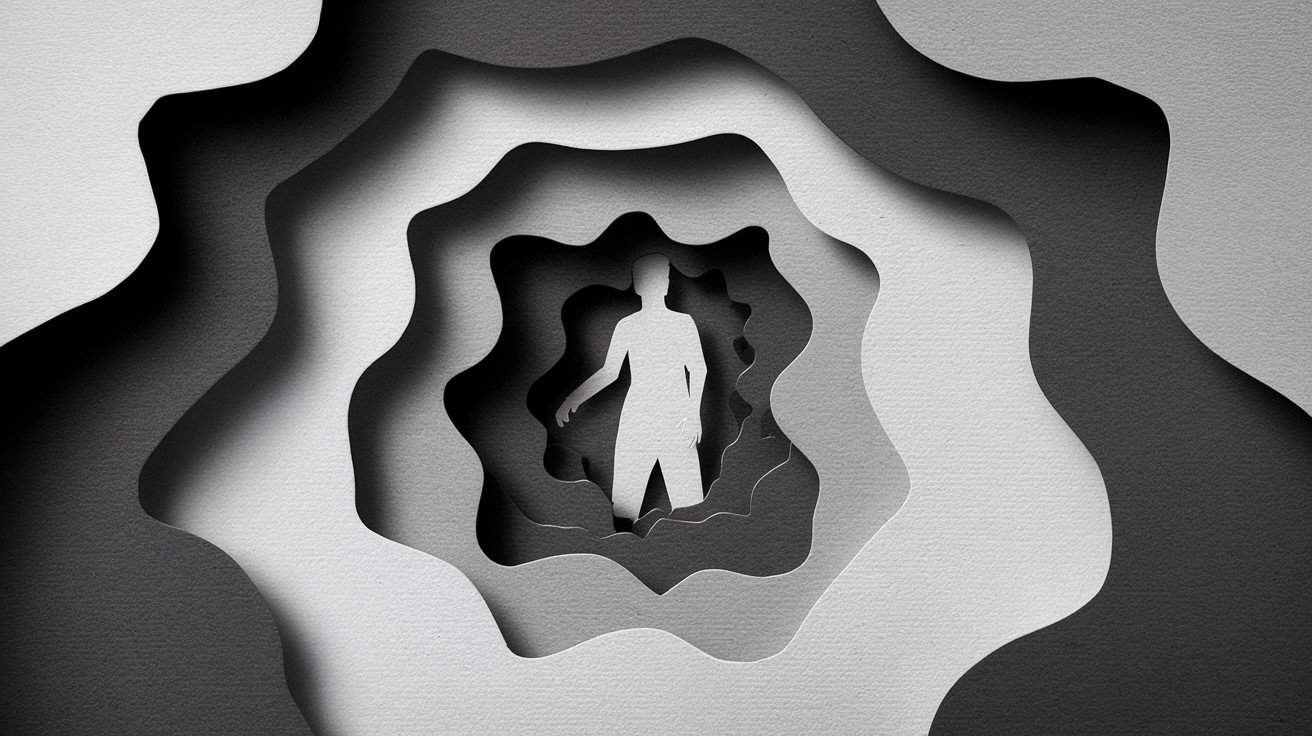I wake up some mornings feeling like I’m trapped behind a thick pane of glass. The world continues moving on the other side, but I’m separate from it all – watching, but unable to truly connect or participate. The thoughts in my head become an echo chamber, each one bouncing off the walls of my mind with increasing intensity.
If you’re reading this, chances are you know this feeling all too well. That sensation of being imprisoned in your own mind, where depression acts as both the jail cell and the warden. The irony is that while we desperately want to break free from this mental prison, there’s also a paradoxical comfort in retreating further into isolation.
Let’s explore why this happens and, more importantly, how we can begin to find our way back to connection and hope. I promise you – there is a path forward, even when it feels impossible to see.
Understanding the Mental Prison of Depression
Depression has a way of building walls around us brick by brick, often so gradually that we don’t notice until we’re completely enclosed. It starts with small thoughts – maybe questioning if anyone really understands us, or if it’s worth the energy to reach out. Before we know it, these thoughts solidify into barriers that feel impenetrable. These walls can isolate us from loved ones, making each day a struggle to connect or express our feelings. Understanding depression’s impact on daily life becomes crucial to breaking free from this self-imposed prison. By recognizing the nuances of our emotional state, we can begin to dismantle these barriers and seek the support that helps us regain our sense of belonging and hope. As these walls grow taller, we may find ourselves withdrawing from friends and activities that once brought us joy, replacing vibrant connections with a sense of isolation. It’s crucial to pay attention to the signs of depression to recognize, as they can serve as powerful indicators that change is needed before we are completely unable to break free. Acknowledging these feelings is the first step toward dismantling those barriers and reclaiming our space in the world. As we isolate ourselves further, the world outside seems to blur, and the once vibrant connections we had fade into distant memories. Understanding waves of depression can feel like being trapped in a storm; we are tossed about, unable to find our footing, even as the sunlight fights to break through the clouds. It’s in these moments, when the walls feel tallest, that we must remember the possibility of reaching out and seeking support to help dismantle the barriers we’ve built. These walls can make the world seem distant and uninviting, isolating us from friends, family, and the support we desperately need. However, there are ways to overcome depression, such as seeking professional help, engaging in open conversations with loved ones, or finding comfort in creative outlets. Taking small steps towards connection can slowly chip away at those walls, allowing light to seep through and reminding us that we’re never truly alone. As we become more isolated, we may struggle with feelings of hopelessness and confusion, often left alone with our thoughts. This loneliness can intensify our fear, particularly when grappling with understanding existential dread, which looms over us like a dark cloud. Each day in isolation reinforces our reluctance to connect, trapping us in a cycle that feels increasingly difficult to break.
I remember sitting in my car one afternoon, meant to be heading to meet friends, but frozen in place by the weight of my thoughts. Everything felt simultaneously overwhelming and pointless. The simple act of opening the car door seemed as impossible as scaling Mount Everest.
This mental imprisonment isn’t just in our heads – it has very real neurological underpinnings. Depression affects our brain’s ability to process emotions and make decisions. What seems irrational to others – like being unable to get out of bed or make a simple phone call – is the result of very real chemical and structural changes in our brains.
The Paradox of Wanting to Be Alone
Here’s where things get complicated: while feeling trapped in our heads is painful, there’s often a strong urge to isolate ourselves further. It’s like being thirsty but pushing away the water that could save us.
This desire for solitude comes from multiple places. Sometimes it’s about energy conservation – when everything feels overwhelming, being alone seems safer. Other times it’s about shame or feeling unworthy of connection. And sometimes, it’s simply because being around others while depressed can feel like trying to speak a language you’ve forgotten.
I’ve learned that this urge to isolate, while understandable, is actually depression’s way of maintaining its hold on us. It’s like a possessive friend who tries to keep us all to themselves, whispering that nobody else will understand anyway.
Breaking Free: Small Steps Toward Light
Breaking free from mental imprisonment doesn’t happen in one dramatic escape. Instead, it’s more like carefully loosening each brick until we create an opening large enough to squeeze through.
Start with the smallest possible action. Maybe it’s opening a window to let fresh air in. Perhaps it’s sending a single text message to someone you trust. These aren’t trivial acts – they’re acts of rebellion against depression’s isolating influence.
One technique that’s helped me is what I call “thought walking.” Instead of trying to fight the thoughts, I take them on a walk with me. The physical movement combined with letting the thoughts flow often helps loosen their grip.
Finding Connection When Everything Feels Impossible
The hardest part about being trapped in our heads is that connection – the very thing that could help us heal – feels the most frightening. But connection doesn’t have to mean immediate deep conversations or lengthy social interactions.
Start with indirect forms of connection. Listen to a podcast where people discuss similar struggles – their voices can help break the silence of isolation. Join online communities where you can participate as much or as little as feels manageable.
Remember that connection isn’t all-or-nothing. You don’t have to jump from isolation to being the life of the party. Sometimes connection is as simple as sitting in a coffee shop, allowing yourself to be in the presence of others without any pressure to interact.
The fog of depression may make it hard to believe, but you’re not alone in this experience. Every day, countless others are fighting similar battles, trying to find their way back to light and connection. Your struggle is valid, your pain is real, and your effort to keep going – even when it feels hopeless – matters.
Take one small step today. Just one. Whether it’s reading this article all the way through, opening a window, or sending a text to someone you trust. Each step, no matter how small, is an act of hope – a quiet rebellion against the prison depression tries to build around us.
Remember: you may be in your head, but you don’t have to stay trapped there forever. The door might be heavy, but it’s not locked. And there are people on the other side, waiting to help you open it.


